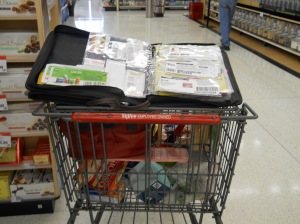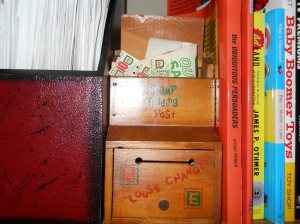Then in the Fall of 2008, K-Mart stores throughout the United States started experimenting with up to $2 double coupon opportunities and my husband David and I traveled to the Dubuque store where I met two women from Wisconsin who had coupon binders. Enthralled, I followed behind them for a few aisles before I approached them.
“I’ve never met someone else with as many coupons as I have,” I gushed, but they weren’t as impressed with me as I was with them, even after I offered them some extra Welch’s jam coupons I had and they didn’t. They weren’t there to make friends, they were on a mission.
30 years without seeing other coupon fanatics.
And now, I see them everywhere. Just in the last 3 months I’ve seen women with coupon binders in nearly every large grocery store I have shopped at.

Something is changing in the coupon community. (yes, despite my lack of face-to-face contact with like-minded couponers, we do have a community. Initially that community was through newsletters in the mailbox and now it is online with websites like www.RefundCents.com) These newbies to the coupon world are a direct result of the TLC Extreme Couponing show. View a half a dozen people fill entire rooms with free products and you might want to do it yourself.
Never mind that the majority of those couponers have access to double coupon stores. And that the featured shopper plans these televised trips with surgical precision, right down to the penny. They order large amounts of coupons from coupon clipping services (one shopper mentioned ordering coupons to the tune of $70), or dig in dumpsters, or as one person on the show claimed, “get their coupon inserts from God.” I don’t know a store on earth that actually stocks 100 packages of one kind of toothbrush or a manager that would be willing to order 29 cases of cereal so I could purchase them. The reality of this reality show isn’t in my realm of possibilities, and neither is it for the majority of coupon users.
And yet, because of the extremes in this show, we now have hoards of people trying to copycat the neat shopping tricks they see on television. And some of them are downright rude, tarnishing the name of couponers everywhere. There are even reports of coupon inserts being stolen from newspapers. Now I hear that some companies are suing ebay and private coupon clipping sites to stop the sale of coupons. Stores like Rite-Aid and Target are changing their coupon policies and companies like Schick are changing the wording on their coupons so as not to allow a coupon user any overage, similar to Procter and Gamble’s October 2010 change of limiting four like coupon per shopping trip.
My opinion? This is just the beginning of the changes we will see in the world of couponing. I wouldn’t go so far as to say that paper coupons will go the way of the dinosaur but I can’t help but look to history for the answers to what might happen.
It wasn’t so long ago that couponing was synonymous with refunding. As a housewife of the 80′s I spent an inordinate amount of time at saving and organizing labels and flattened packages for what amounted to approximately $100 a month mailed to me in manufacturer refunds on their products. I piled gift-wrapped packages of refund premiums underneath our Christmas tree every year and outfitted my entire family in free t-shirts. Unfortunately, a refund “racket” existed and involved fraudulent activity that eventually ruined it for the rest of us. You don’t even hear of refunding anymore. Refunds have become “rebates” and the offers are fewer and farther between. Women of a certain age will remember the trading stamps era in the 50′s and 60′s. At one point, 82% of households in the United States saved trading stamps. Housewives loved them. Where are those trading stamps now? (besides displayed on my desk as a conversation piece?)

Coupons have been around, in some way, shape or form, since the late 1880′s. And with the renewed interest in coupons it is unlikely they will just disappear off the face of the marketing landscape. But are there additional changes in store for couponers?
I think you can bet on it.
No comments:
Post a Comment